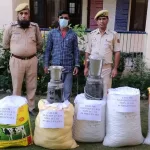GREENING THE SCORCHED EARTH
In recent weeks, Srinagar—long known for its temperate summers, cool breezes wafting through chinar-lined boulevards, and serene Dal Lake shimmer—found itself scorched by a merciless heatwave. The mercury breached 37 degrees Celsius, an event so rare and unforgiving that it startled even the elderly who had lived through the regions changing seasons since the 1950s. The last time such heat was recorded was in 1953, and this new record serves not just as a meteorological anomaly, but as a stark warning—a red signal fluttering against the blue canvas of the Kashmir sky.The traditional narrative of Kashmir as a haven of cool weather, a retreat for those escaping the sizzling plains of India, is slowly unraveling. The gentle summers that once caressed the valley now arrive with a searing vengeance. The sudden rise in temperatures has not only strained power grids, caused water shortages, and wilted crops, but has also ignited a larger, more urgent conversation: what are we doing to our environment, and what can we still do to save it?
Among the many strategies available to counteract climate change and the phenomenon of urban heat islands, one remains deceptively simple and profoundly impactful: planting trees. In a world spiraling toward environmental chaos, planting trees is both a gesture of hope and an act of responsibility. In the specific context of Srinagar, this initiative carries both ecological and cultural weight. Trees are not just foliage in this part of the world; they are a part of the Valley’s poetic soul, its historic memory, and now, potentially, its salvation.Srinagar’s ecosystem was once harmoniously interwoven with its tree canopy. From the majestic chinars that have stood as sentinels of time, to the willows bending towards water channels, trees were not decorative but elemental. They offered shade, balanced the temperature, filtered the air, and formed habitats for diverse species.More than that, they were part of social life—children played under their shade, elders rested in their cool shelter, and poets wrote verses leaning against their trunks. The diminishing tree cover, whether due to unchecked urbanization, illegal constructions, or apathy, has played no small part in tilting the Valley’s climatic balance.
Heatwaves are no longer distant threats or news stories confined to Delhi or Rajasthan. Their arrival in Srinagar means that the climate crisis has not just knocked on the Valley’s door—it has entered uninvited and is making itself at home. In such a scenario, planting trees is not a romantic idealism but a scientific necessity.Trees act as natural air conditioners. Through the process of transpiration, they release moisture into the atmosphere, cooling the surrounding air. Their canopies intercept solar radiation, reducing the heat that would otherwise be absorbed by concrete surfaces. A mature tree can have the same cooling effect as ten air conditioners running for twenty hours a day—and it does so silently, without carbon emissions.Moreover, trees play an instrumental role in carbon sequestration. They absorb carbon dioxide—the primary greenhouse gas driving global warming—and lock it away in their trunks and roots. A single mature tree can absorb up to 48 pounds of CO₂ per year. When multiplied over a landscape, the environmental returns are immense. This is not to mention their capacity to arrest soil erosion, recharge groundwater, and provide homes to birds and pollinators who are quietly vanishing from our cities.
Yet the act of planting trees must move beyond symbolism and tokenism. It must become a sustained, community-driven, scientifically-informed campaign. In the context of Srinagar, which has seen rampant urban sprawl and shrinking green belts, afforestation must be integrated with urban planning. It is not enough to plant trees in parks or along highways.Trees must return to school yards, hospital premises, riverbanks, temple courtyards, mosques, graveyards, and residential colonies. Rooftop gardens, vertical green walls, and micro-forests inspired by the Miyawaki method can be adopted to maximize green cover even in densely populated spaces.
Furthermore, it is essential to plant indigenous species rather than exotic imports that may disrupt the local ecology. The chinar, the mulberry, the walnut, the deodar, the almond—these are not merely trees but part of the cultural and environmental DNA of Kashmir. Their reintroduction and protection can become a confluence of heritage conservation and climate action.Community participation is key. While government policies and institutional support form the backbone of any environmental initiative, real success is only possible when the public feels ownership. Educational institutions can involve students in plantation drives, housing societies can commit to neighborhood greening, religious leaders can advocate ecological responsibility from pulpits, and media can amplify success stories and create a culture of awareness.The excessive heat that recently baked Srinagar is more than just a passing weather event—it is a symptom of a system collapsing under the weight of indifference and excess. Planting trees will not instantly reverse this crisis, but it offers a tangible and attainable beginning. It is an act that benefits future generations, a moral offering to children who may otherwise inherit a barren land.This summer’s fury must not be forgotten when the autumn chill returns. Memory is short, especially when the winds change. But let this unprecedented heat serve as a collective awakening. Let it compel planners, poets, politicians, and pedestrians alike to look at a sapling not as an ornament, but as an instrument of survival. In planting a tree, we are not merely placing roots in the soil—we are anchoring hope in the future.The Valley has always found strength in its resilience. It has survived invasions, calamities, exiles, and erasures. Now it must survive climate change. The chinar leaves that once fell in soft spirals must not be replaced by scorching gusts and smog. For that, we must plant trees—again, and again, and again. Until the skyline of Srinagar is once more dappled with green and the breeze smells not of heat, but of healing.
(Author is RK Columnist and can be reached at: [email protected])








